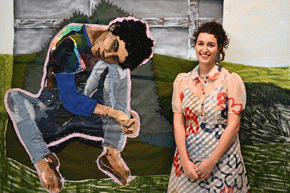Wozzeck: an opera review by Victor Grynberg
After the glorious melodies of LA BOHEME and TURANDOT Opera Australia’s latest production is Alban Berg’s atonal opera, considered today a modern opera but written almost 100 years ago in 1925.

Michael Honeyman as Wozzeck and ensemble in Opera Australia’s 2019 production of Wozzeck at the Sydney Opera House.
Photo credit: Keith Saunders
Atonal music is technically very hard to sing and play, as the notes do not follow any “normal” pattern and jump all over the place.
Yet an audience rarely exposed to this type of music gave thunderous applause at the end of the 90-minute single act. Many reasons were behind this, but for this critic, it starts with the work of Director and Artist William Kentridge. Working from his studio in Johannesburg, the acclaimed artist built a mock set as he developed his ideas for this completely new production, co-funded by OA, The Met , Salzburg and the Canadian Opera Company. Though dark and by no means uplifting the combination of the sets, the costumes and particularly Kentridge’s superb artworks makes this a production where the eyes are glued to the set at all times.
This dark play, called Woyzeck originally, was actually never completed before author Georg Buchner died tragically in 1837 at the age of only 23. First staged in 1913 Berg saw the drama the next year and immediately decided to make an opera of this. Berg had been a pupil of Arnold Schoenberg’s from the Second Viennese School, so his atonal music is no surprise. But cleverly the composer gave different voices for each of the principles and it is there that the local contribution to this opera really comes through. Anyone who has tried to sing a song can hear when they’ve hit a flat note. Imagine doing the same with notes that don’t follow suit.
Wozzeck’s partner Marie is sung magnificently by Lorina Gore . I’ve admired her performances in many “traditional” operas, but I felt that artistically the way she met the difficult challenges of this role saw her perform at an even greater height.
Naturally, the heaviest weight is carried by Michael Honeyman as Wozzeck himself. A character at times deranged and plagued by total uncertainty whether singing or speaking sing-song style, this is a role that simply could destroy the whole production if the lead couldn’t bring the audience with him. As he had done in Korngold’s “Die Tote Stadt”, another uber challenging role, Honeyman reached his highest standard with this performance.
The opera’s opening parts feature a trio of actors in Wozzeck, the Drum Major and the Captain. John Daszak making his OA debut as the awful Drum Major has real masculine power in his acting and singing. May he return soon. John Longmuir, young but already an OA veteran similarly carried his role to a very high standard.

Victor Grynberg
In what clearly was an excellently cast performance these four leads were extremely well supported by Dominica Matthews, Richard Anderson and Gennadi Dubinsky and more.
I’ve written previously of the very high standards in recent years of the OA chorus. In a dark performance unlikely to be repeated soon, the choir, under the keen direction of Anthony Hunt gave strong support to the action on stage.
Similarly, the Children’s Choir were pre-eminent in their appearance.
Co-director Belgian Luc de Wit has worked with Kentridge before and clearly, their combination is world-class.
All this needs the music to go with it.
Difficult to play, but essential, the OA orchestra was in fine form, with their well versed Italian leader Andrea Molino at the helm.
A visual feast, a music style not for everyone but in terms of artistic achievement a very well deserved 5 stars
WOZZECK
Joan Sutherland Theatre
Sydney Opera House
January 30 2019







